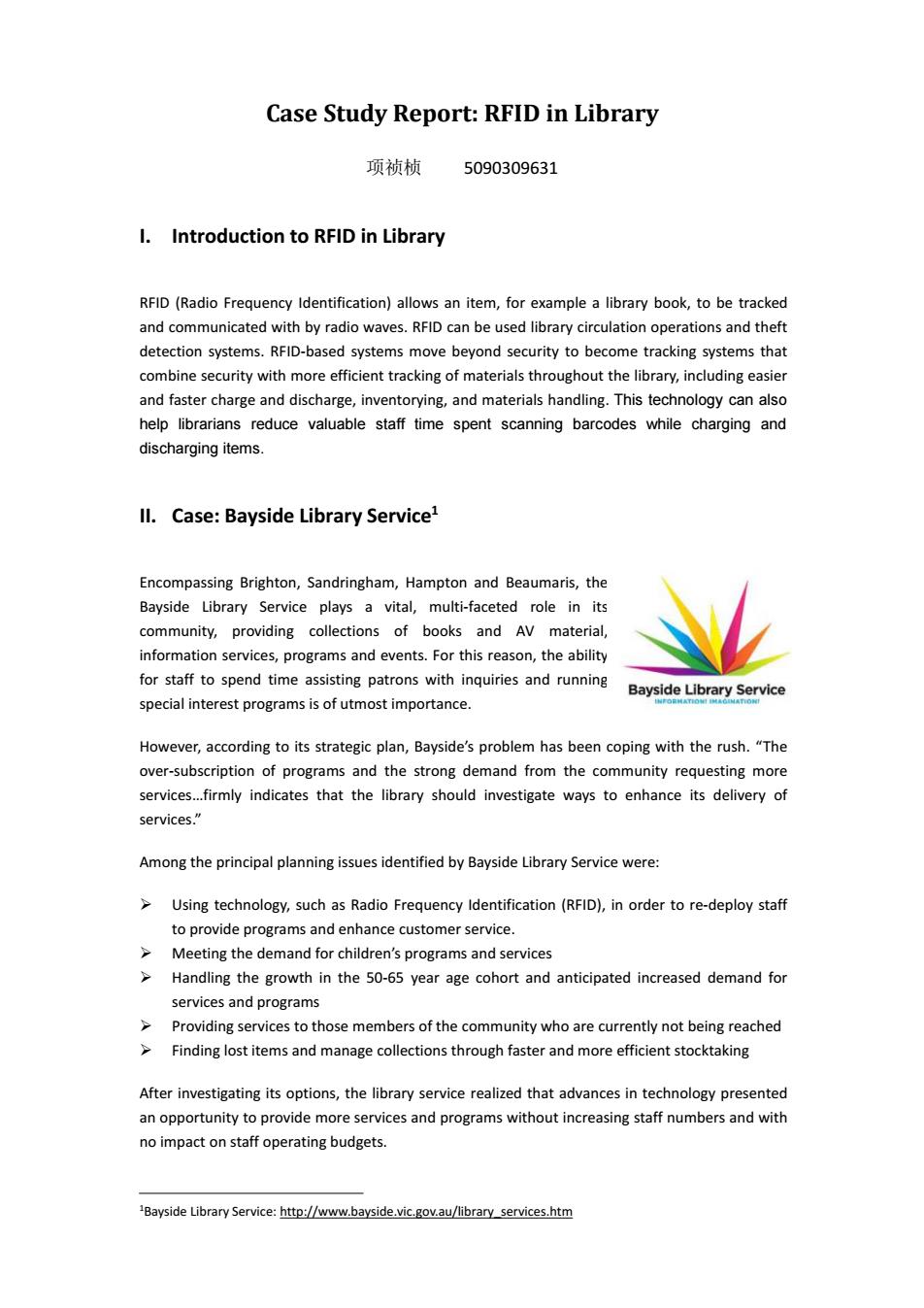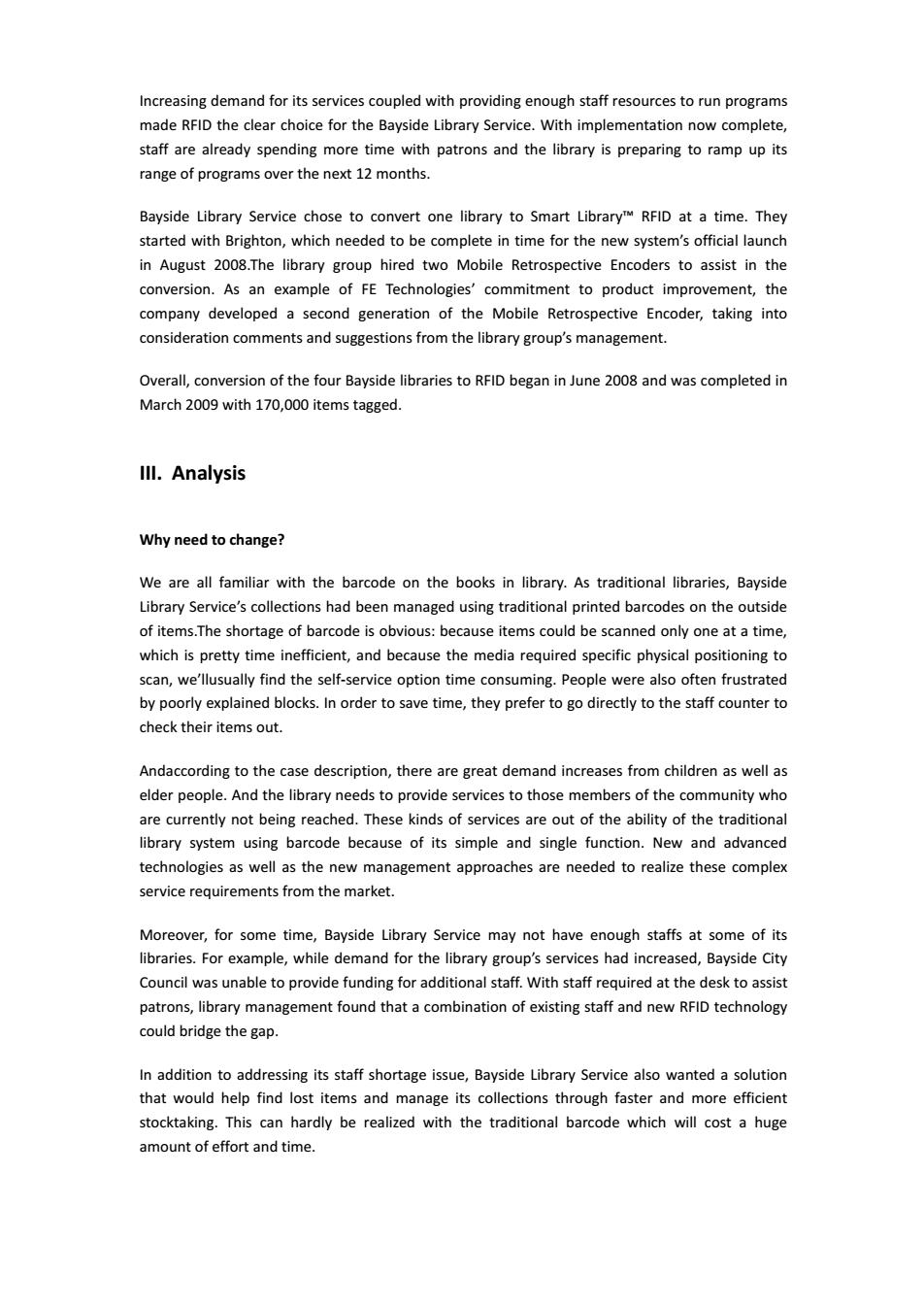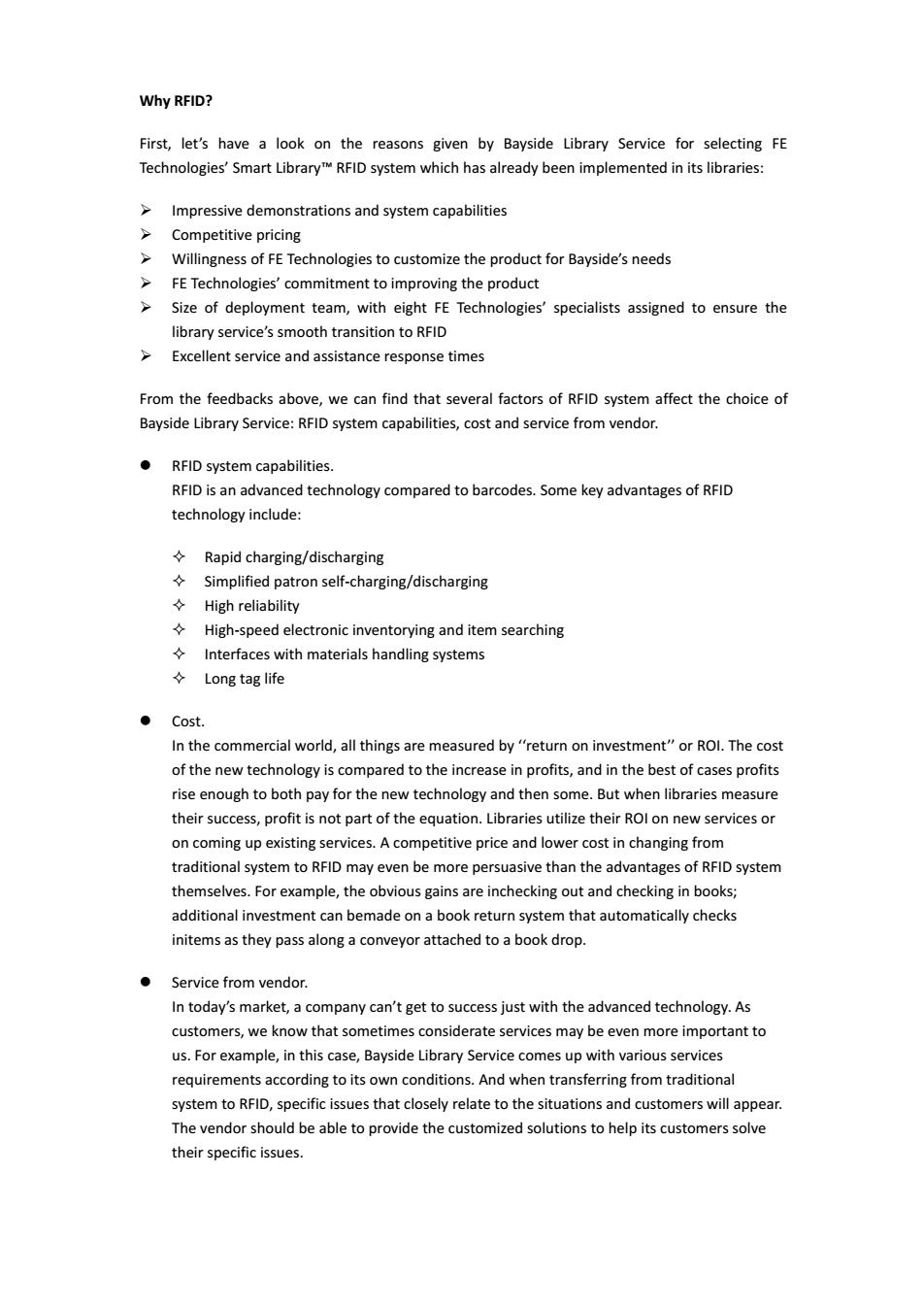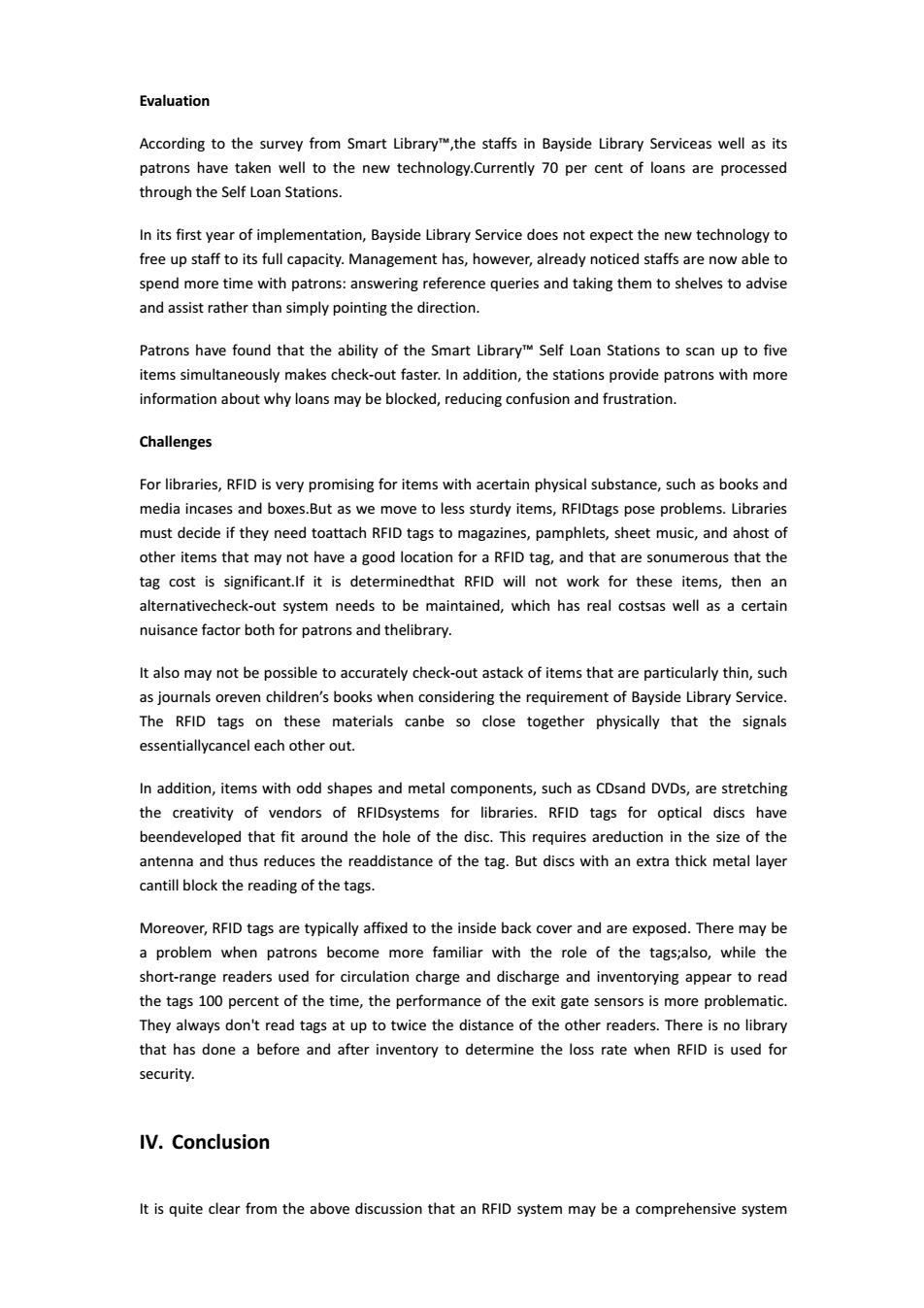
Case Study Report:RFID in Library 项祯桢 5090309631 I.Introduction to RFID in Library RFID(Radio Frequency Identification)allows an item,for example a library book,to be tracked and communicated with by radio waves.RFID can be used library circulation operations and theft detection systems.RFID-based systems move beyond security to become tracking systems that combine security with more efficient tracking of materials throughout the library,including easier and faster charge and discharge,inventorying,and materials handling.This technology can also help librarians reduce valuable staff time spent scanning barcodes while charging and discharging items. Il.Case:Bayside Library Servicel Encompassing Brighton,Sandringham,Hampton and Beaumaris,the Bayside Library Service plays a vital,multi-faceted role in its community,providing collections of books and AV material, information services,programs and events.For this reason,the ability for staff to spend time assisting patrons with inquiries and running Bayside Library Service special interest programs is of utmost importance. However,according to its strategic plan,Bayside's problem has been coping with the rush."The over-subscription of programs and the strong demand from the community requesting more services...firmly indicates that the library should investigate ways to enhance its delivery of services." Among the principal planning issues identified by Bayside Library Service were: >Using technology,such as Radio Frequency Identification(RFID),in order to re-deploy staff to provide programs and enhance customer service. >Meeting the demand for children's programs and services >Handling the growth in the 50-65 year age cohort and anticipated increased demand for services and programs >Providing services to those members of the community who are currently not being reached Finding lost items and manage collections through faster and more efficient stocktaking After investigating its options,the library service realized that advances in technology presented an opportunity to provide more services and programs without increasing staff numbers and with no impact on staff operating budgets. Bayside Library Service:http://www.bayside.vic.gov.au/library services.htm
Case Study Report: RFID in Library 项祯桢 5090309631 I. Introduction to RFID in Library RFID (Radio Frequency Identification) allows an item, for example a library book, to be tracked and communicated with by radio waves. RFID can be used library circulation operations and theft detection systems. RFID-based systems move beyond security to become tracking systems that combine security with more efficient tracking of materials throughout the library, including easier and faster charge and discharge, inventorying, and materials handling. This technology can also help librarians reduce valuable staff time spent scanning barcodes while charging and discharging items. II. Case: Bayside Library Service 1 Encompassing Brighton, Sandringham, Hampton and Beaumaris, the Bayside Library Service plays a vital, multi-faceted role in its community, providing collections of books and AV material, information services, programs and events. For this reason, the ability for staff to spend time assisting patrons with inquiries and running special interest programs is of utmost importance. However, according to its strategic plan, Bayside’s problem has been coping with the rush. “The over-subscription of programs and the strong demand from the community requesting more services…firmly indicates that the library should investigate ways to enhance its delivery of services.” Among the principal planning issues identified by Bayside Library Service were: Using technology, such as Radio Frequency Identification (RFID), in order to re-deploy staff to provide programs and enhance customer service. Meeting the demand for children’s programs and services Handling the growth in the 50-65 year age cohort and anticipated increased demand for services and programs Providing services to those members of the community who are currently not being reached Finding lost items and manage collections through faster and more efficient stocktaking After investigating its options, the library service realized that advances in technology presented an opportunity to provide more services and programs without increasing staff numbers and with no impact on staff operating budgets. 1Bayside Library Service: http://www.bayside.vic.gov.au/library_services.htm

Increasing demand for its services coupled with providing enough staff resources to run programs made RFID the clear choice for the Bayside Library Service.With implementation now complete, staff are already spending more time with patrons and the library is preparing to ramp up its range of programs over the next 12 months. Bayside Library Service chose to convert one library to Smart LibraryTM RFID at a time.They started with Brighton,which needed to be complete in time for the new system's official launch in August 2008.The library group hired two Mobile Retrospective Encoders to assist in the conversion.As an example of FE Technologies'commitment to product improvement,the company developed a second generation of the Mobile Retrospective Encoder,taking into consideration comments and suggestions from the library group's management. Overall,conversion of the four Bayside libraries to RFID began in June 2008 and was completed in March 2009 with 170,000 items tagged. Ill.Analysis Why need to change? We are all familiar with the barcode on the books in library.As traditional libraries,Bayside Library Service's collections had been managed using traditional printed barcodes on the outside of items.The shortage of barcode is obvious:because items could be scanned only one at a time, which is pretty time inefficient,and because the media required specific physical positioning to scan,we'llusually find the self-service option time consuming.People were also often frustrated by poorly explained blocks.In order to save time,they prefer to go directly to the staff counter to check their items out. Andaccording to the case description,there are great demand increases from children as well as elder people.And the library needs to provide services to those members of the community who are currently not being reached.These kinds of services are out of the ability of the traditional library system using barcode because of its simple and single function.New and advanced technologies as well as the new management approaches are needed to realize these complex service requirements from the market. Moreover,for some time,Bayside Library Service may not have enough staffs at some of its libraries.For example,while demand for the library group's services had increased,Bayside City Council was unable to provide funding for additional staff.With staff required at the desk to assist patrons,library management found that a combination of existing staff and new RFID technology could bridge the gap. In addition to addressing its staff shortage issue,Bayside Library Service also wanted a solution that would help find lost items and manage its collections through faster and more efficient stocktaking.This can hardly be realized with the traditional barcode which will cost a huge amount of effort and time
Increasing demand for its services coupled with providing enough staff resources to run programs made RFID the clear choice for the Bayside Library Service. With implementation now complete, staff are already spending more time with patrons and the library is preparing to ramp up its range of programs over the next 12 months. Bayside Library Service chose to convert one library to Smart Library™ RFID at a time. They started with Brighton, which needed to be complete in time for the new system’s official launch in August 2008.The library group hired two Mobile Retrospective Encoders to assist in the conversion. As an example of FE Technologies’ commitment to product improvement, the company developed a second generation of the Mobile Retrospective Encoder, taking into consideration comments and suggestions from the library group’s management. Overall, conversion of the four Bayside libraries to RFID began in June 2008 and was completed in March 2009 with 170,000 items tagged. III. Analysis Why need to change? We are all familiar with the barcode on the books in library. As traditional libraries, Bayside Library Service’s collections had been managed using traditional printed barcodes on the outside of items.The shortage of barcode is obvious: because items could be scanned only one at a time, which is pretty time inefficient, and because the media required specific physical positioning to scan, we’llusually find the self-service option time consuming. People were also often frustrated by poorly explained blocks. In order to save time, they prefer to go directly to the staff counter to check their items out. Andaccording to the case description, there are great demand increases from children as well as elder people. And the library needs to provide services to those members of the community who are currently not being reached. These kinds of services are out of the ability of the traditional library system using barcode because of its simple and single function. New and advanced technologies as well as the new management approaches are needed to realize these complex service requirements from the market. Moreover, for some time, Bayside Library Service may not have enough staffs at some of its libraries. For example, while demand for the library group’s services had increased, Bayside City Council was unable to provide funding for additional staff. With staff required at the desk to assist patrons, library management found that a combination of existing staff and new RFID technology could bridge the gap. In addition to addressing its staff shortage issue, Bayside Library Service also wanted a solution that would help find lost items and manage its collections through faster and more efficient stocktaking. This can hardly be realized with the traditional barcode which will cost a huge amount of effort and time

Why RFID? First,let's have a look on the reasons given by Bayside Library Service for selecting FE Technologies'Smart LibraryTM RFID system which has already been implemented in its libraries: >Impressive demonstrations and system capabilities >Competitive pricing >Willingness of FE Technologies to customize the product for Bayside's needs >FE Technologies'commitment to improving the product Size of deployment team,with eight FE Technologies'specialists assigned to ensure the library service's smooth transition to RFID >Excellent service and assistance response times From the feedbacks above,we can find that several factors of RFID system affect the choice of Bayside Library Service:RFID system capabilities,cost and service from vendor. RFID system capabilities. RFID is an advanced technology compared to barcodes.Some key advantages of RFID technology include: Rapid charging/discharging Simplified patron self-charging/discharging 令High reliability High-speed electronic inventorying and item searching H Interfaces with materials handling systems 女Long tag life ●Cost In the commercial world,all things are measured by "return on investment"or ROl.The cost of the new technology is compared to the increase in profits,and in the best of cases profits rise enough to both pay for the new technology and then some.But when libraries measure their success,profit is not part of the equation.Libraries utilize their ROl on new services or on coming up existing services.A competitive price and lower cost in changing from traditional system to RFID may even be more persuasive than the advantages of RFID system themselves.For example,the obvious gains are inchecking out and checking in books; additional investment can bemade on a book return system that automatically checks initems as they pass along a conveyor attached to a book drop. ●Service from vendor. In today's market,a company can't get to success just with the advanced technology.As customers,we know that sometimes considerate services may be even more important to us.For example,in this case,Bayside Library Service comes up with various services requirements according to its own conditions.And when transferring from traditional system to RFID,specific issues that closely relate to the situations and customers will appear. The vendor should be able to provide the customized solutions to help its customers solve their specific issues
Why RFID? First, let’s have a look on the reasons given by Bayside Library Service for selecting FE Technologies’ Smart Library™ RFID system which has already been implemented in its libraries: Impressive demonstrations and system capabilities Competitive pricing Willingness of FE Technologies to customize the product for Bayside’s needs FE Technologies’ commitment to improving the product Size of deployment team, with eight FE Technologies’ specialists assigned to ensure the library service’s smooth transition to RFID Excellent service and assistance response times From the feedbacks above, we can find that several factors of RFID system affect the choice of Bayside Library Service: RFID system capabilities, cost and service from vendor. RFID system capabilities. RFID is an advanced technology compared to barcodes. Some key advantages of RFID technology include: Rapid charging/discharging Simplified patron self-charging/discharging High reliability High-speed electronic inventorying and item searching Interfaces with materials handling systems Long tag life Cost. In the commercial world, all things are measured by ‘‘return on investment’’ or ROI. The cost of the new technology is compared to the increase in profits, and in the best of cases profits rise enough to both pay for the new technology and then some. But when libraries measure their success, profit is not part of the equation. Libraries utilize their ROI on new services or on coming up existing services. A competitive price and lower cost in changing from traditional system to RFID may even be more persuasive than the advantages of RFID system themselves. For example, the obvious gains are inchecking out and checking in books; additional investment can bemade on a book return system that automatically checks initems as they pass along a conveyor attached to a book drop. Service from vendor. In today’s market, a company can’t get to success just with the advanced technology. As customers, we know that sometimes considerate services may be even more important to us. For example, in this case, Bayside Library Service comes up with various services requirements according to its own conditions. And when transferring from traditional system to RFID, specific issues that closely relate to the situations and customers will appear. The vendor should be able to provide the customized solutions to help its customers solve their specific issues

Evaluation According to the survey from Smart LibraryTM,the staffs in Bayside Library Serviceas well as its patrons have taken well to the new technology.Currently 70 per cent of loans are processed through the Self Loan Stations. In its first year of implementation,Bayside Library Service does not expect the new technology to free up staff to its full capacity.Management has,however,already noticed staffs are now able to spend more time with patrons:answering reference queries and taking them to shelves to advise and assist rather than simply pointing the direction. Patrons have found that the ability of the Smart LibraryTM Self Loan Stations to scan up to five items simultaneously makes check-out faster.In addition,the stations provide patrons with more information about why loans may be blocked,reducing confusion and frustration. Challenges For libraries,RFID is very promising for items with acertain physical substance,such as books and media incases and boxes.But as we move to less sturdy items,RFIDtags pose problems.Libraries must decide if they need toattach RFID tags to magazines,pamphlets,sheet music,and ahost of other items that may not have a good location for a RFID tag,and that are sonumerous that the tag cost is significant.If it is determinedthat RFID will not work for these items,then an alternativecheck-out system needs to be maintained,which has real costsas well as a certain nuisance factor both for patrons and thelibrary. It also may not be possible to accurately check-out astack of items that are particularly thin,such as journals oreven children's books when considering the requirement of Bayside Library Service. The RFID tags on these materials canbe so close together physically that the signals essentiallycancel each other out. In addition,items with odd shapes and metal components,such as CDsand DVDs,are stretching the creativity of vendors of RFIDsystems for libraries.RFID tags for optical discs have beendeveloped that fit around the hole of the disc.This requires areduction in the size of the antenna and thus reduces the readdistance of the tag.But discs with an extra thick metal layer cantill block the reading of the tags. Moreover,RFID tags are typically affixed to the inside back cover and are exposed.There may be a problem when patrons become more familiar with the role of the tags;also,while the short-range readers used for circulation charge and discharge and inventorying appear to read the tags 100 percent of the time,the performance of the exit gate sensors is more problematic. They always don't read tags at up to twice the distance of the other readers.There is no library that has done a before and after inventory to determine the loss rate when RFID is used for security. IV.Conclusion It is quite clear from the above discussion that an RFID system may be a comprehensive system
Evaluation According to the survey from Smart Library™,the staffs in Bayside Library Serviceas well as its patrons have taken well to the new technology.Currently 70 per cent of loans are processed through the Self Loan Stations. In its first year of implementation, Bayside Library Service does not expect the new technology to free up staff to its full capacity. Management has, however, already noticed staffs are now able to spend more time with patrons: answering reference queries and taking them to shelves to advise and assist rather than simply pointing the direction. Patrons have found that the ability of the Smart Library™ Self Loan Stations to scan up to five items simultaneously makes check-out faster. In addition, the stations provide patrons with more information about why loans may be blocked, reducing confusion and frustration. Challenges For libraries, RFID is very promising for items with acertain physical substance, such as books and media incases and boxes.But as we move to less sturdy items, RFIDtags pose problems. Libraries must decide if they need toattach RFID tags to magazines, pamphlets, sheet music, and ahost of other items that may not have a good location for a RFID tag, and that are sonumerous that the tag cost is significant.If it is determinedthat RFID will not work for these items, then an alternativecheck-out system needs to be maintained, which has real costsas well as a certain nuisance factor both for patrons and thelibrary. It also may not be possible to accurately check-out astack of items that are particularly thin, such as journals oreven children’s books when considering the requirement of Bayside Library Service. The RFID tags on these materials canbe so close together physically that the signals essentiallycancel each other out. In addition, items with odd shapes and metal components, such as CDsand DVDs, are stretching the creativity of vendors of RFIDsystems for libraries. RFID tags for optical discs have beendeveloped that fit around the hole of the disc. This requires areduction in the size of the antenna and thus reduces the readdistance of the tag. But discs with an extra thick metal layer cantill block the reading of the tags. Moreover, RFID tags are typically affixed to the inside back cover and are exposed. There may be a problem when patrons become more familiar with the role of the tags;also, while the short-range readers used for circulation charge and discharge and inventorying appear to read the tags 100 percent of the time, the performance of the exit gate sensors is more problematic. They always don't read tags at up to twice the distance of the other readers. There is no library that has done a before and after inventory to determine the loss rate when RFID is used for security. IV. Conclusion It is quite clear from the above discussion that an RFID system may be a comprehensive system

that addresses both the security and materials tracking needs of a library.RFID in the library is not a threat if best practices guidelines followed religiously,that it speeds up book borrowing and inventories and frees staff to do more user-service tasks.The technology saves money too and quickly gives a return on investment
that addresses both the security and materials tracking needs of a library. RFID in the library is not a threat if best practices guidelines followed religiously, that it speeds up book borrowing and inventories and frees staff to do more user-service tasks. The technology saves money too and quickly gives a return on investment